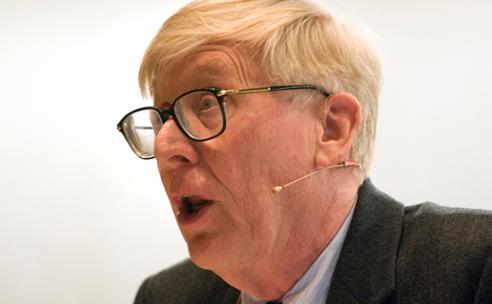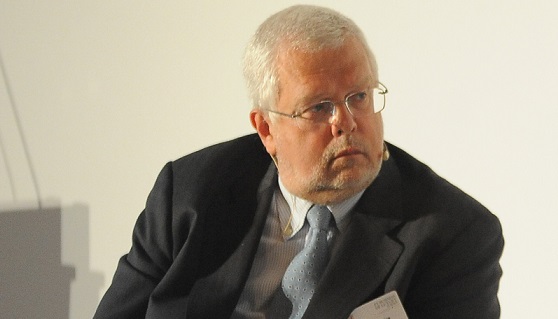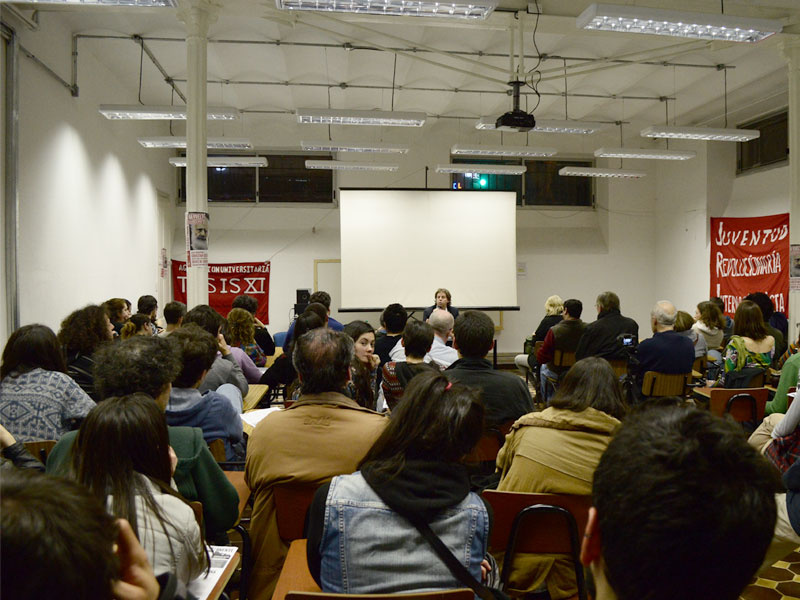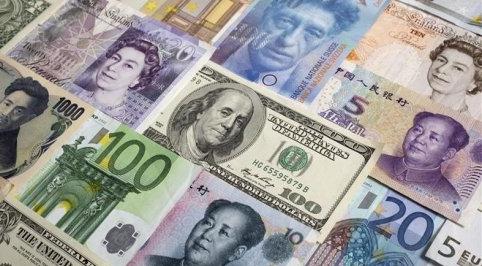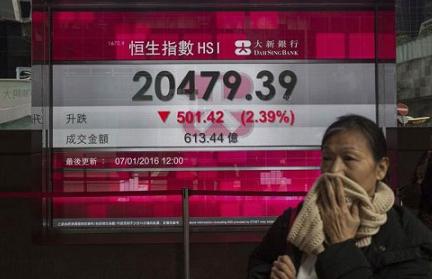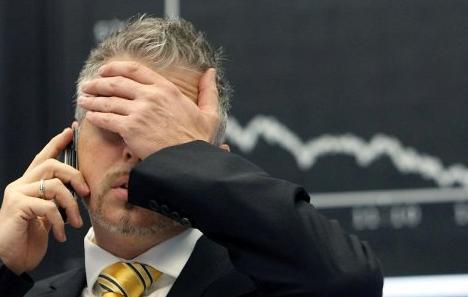The Great Depression of the twenty-first century
24/03/2009 Estrategia Internacional No 25
“AMERICA’S recession is likely to be long and deep if the latest employment numbers are anything to go by. America shed more jobs in November than in any month in the past 34 years, according to figures released on Friday December 5th by the Bureau of Labour Statistics. The fall in employment of 533,000 is far worse even the most pessimistic of forecasters had counted on. Not only are the job losses deeper than expected, workers have been shed across almost the whole of the economy.”
A Turning Point in Post-War History
We are a turning point in world history. We have to see the present downturn as being a crisis during the decline of capitalism.
Why is it a turning point? The term has almost become banal when applied to the present time. We are told that we live in historic times. At the same time, we are told that it is a time of austerity and we have to be grateful to governments using the formerly despised Keynesian tools to go in for public works and increased welfare benefits.
From the point of view of the majority it is always a time of austerity when it comes to wages and government spending on welfare. However, when governments bail out banks, car companies and implicitly small business, indeed the whole economy, it is clearly a new period. An article in the FT, on Friday 28th November 2008, bewailed the fact that the Thatcher gains have been lost as a result. Indeed, the new period of finance capital is at an end, without an alternative.
So it is a turning point in the first instance because the capital’s strategy of using finance capital has reached a logical terminus. It is turning point also, because capital has no new strategy, implying, therefore that we are in for a period of systemic instability or disintegration or both. It is a turning point, in the second place, because the long period of relative stability based on Stalinism and the Cold War has finally lost its impact. It came to an end some 16 years ago, when the Soviet Union came to an end, but a world frozen by the counter-revolutionary nature of Stalinism needs time to thaw out both objectively and subjectively. The subjective aspect has been the most difficult because the demise of Communist Parties whether in reality, or both in name and reality, has not led to the far left, or Marxists founding anything new, either theoretically or in practice.
Trotsky long ago pointed out that in a revolutionary situation the left faces new tasks and the old parties are inadequate and have therefore to change. There is no revolutionary situation but we are being led that way as the old system fails and we can expect that the intellectual and everyday climate will change with it. That is the third turning point. The old respect for the market whether as market fundamentalism or as the social democratic market has gone. Again there is no replacement, but the attempts by the Conservatives in the UK and the Republican right in the USA to argue for letting the banks and car companies go to the wall, has forced otherwise conservative politicians to ridicule the arguments for socio-economic natural selection.
The fourth turning point is that the downfall of capital at the centre of the world economy has led automatically to a crisis in every country precisely because of the globalised and integrated nature of the world economy, or in Marxist terms the highly socialised nature of global capital. If the governments did not intervene, it is quite possible that the economies would only reach equilibrium at third world levels of unemployment, if they reached any equilibrium at all. The political danger has been very much in the minds of big capital from the start. That is the importance of keeping Labour in government and electing Obama. They both represent what one may call central capital as opposed to fringe capital. Capital at this point is far more class conscious than the working class and its central constituents understand the damage done in the last period, and the need to recoup in order to survive. They are therefore counting on limited forms of concessions, but they cannot work.
So the present crisis is a crisis of the system. However, there is a further aspect which we can consider from what has been said. I have said that it is a turning point because it ushers in a new period of systemic instability. The reason lies in the end of the previous forms of stability which have been summarized as Stalinism, the Cold War and finance capital. In fact, it is broader than that. We are talking of imperialism, war, Stalinism, finance capital and the welfare state. Put another way, a declining capitalism is inherently unstable but it has managed to find a series of forms which have allowed it to survive. These forms have been generally inhuman and barbaric as in the case of imperialism, war, and Stalinism. Social democratic forms are of a different order but the system found that it could not live with them and turned to finance capital, which has now imploded.
Why does the system need these forms? Precisely because it is in decline. A declining system does not have to be one in which production or innovate stagnates, although that can happen. It has not happened in the past and there is no reason to assume that it will happen to capitalism. It is enough that its fundamental law, the law of value, functions less and less well either in breadth or in depth.
In this respect, Marx does call the capitalist system senile because of its tendency to a decline in the rate of profit. I reject the fashion in certain circles of fetishizing the concept, but I think we can regard it as a long term tendency which may tend to alternative ways of raising profits, such as the use of imperialism or finance capital. We cannot calculate rates of profit accurately partly because they are not reported correctly in accounts, as has become very clear, and partly because those accounts are not in value terms. Productive and unproductive labour, with the latter being part of surplus value cannot be easily calculated.
So I would reject simplistic arguments that the present crisis is simply caused by a falling rate of profit, except in the very long term. We may regard the falling rate of profit as the basis for the turn to finance capital in the late nineteenth century in the UK, but that is as far as it goes.
Rather, I would see the present in terms of Trotsky’s concept of the long wave both methodologically and in reality. Marxism does not turn its categories into self-operating entities standing above mankind, even though the market does place economic entities above humanity. In the latter case, the capitalist system stands above mankind but it does so in the interests of capital and so the capitalist class and hence when we observe the movement of categories we have to see them in both class terms and within history. Trotsky effectively argues that upturns occur when the capitalist class has triumphed over its enemies and the conditions for the deployment of capital are favourable. The instances he quotes are ones of war and revolution. In this instance, I would argue that the forces favourable to the ruling class have become exhausted. Even though the working class is not politically militant at this point, it has not been defeated. Every turn of the long wave is unique because it depends on the particular configuration of political economic circumstances in existence. In short, the global perspective for the ruling class does not look good, even if the global workforce is not a class and there is no accepted political leadership. The political reason is that the previous strategies of Stalinism, social and democracy and finance capital are played out. There are times, when historical forces act outside human consciousness and compel mankind to find solutions.
The downturn
Concretely it would appear that the world has probably entered what might be called the third great depression, if we count the long depression at the end of the 19th Century as the first and the 1929 depression as the second. Engels remarked that crises were getting deeper towards the end of his life and it has proved correct. The real question is why there have been no depressions in the period since the war.
In the period down to the sixties, there was almost a consensus among Marxists, of different outlooks, that the absence of a depression had to do with the military Keynesianism that had been adopted and the associated Bretton Woods agreements. The world economy had been dominated by British Imperialism until the 1920s, when the United States moved aggressively to take over and it became the overwhelming imperial power during and after World War 2. The fate, therefore, of the world economy was determined by the progress of the US economy, and it remained closely tied to military production for the whole of the twentieth century. Marxists differed only on the degree of importance, not on the significance of the military sector.
Rather oddly, this insight seems to have been lost in the present period because its logic leads to the view that the end of the Cold War must lead to a return to classical crises. In fact, the Cold War was more than just military Keynesianism, it was also a global system of control in which Stalinism was both an enemy and a de facto partner. Without Stalinism, the global political economy of the period from the last world war would have been very different. Stalinism provided the basis for the ideology of anti-communism which was highly effective in both maintaining the Cold War and controlling the working class in that period. The Stalinist Communist Parties played their part in preventing the working class going for more militant action. Control over the working class was crucial in allowing the ruling class to accept the premise of the Bretton Woods agreements, which was to accept growth as its economic goal and its corollary-full employment and a limited welfare state in the developed countries.
The end of Stalinism and the Cold War was also the end of the post-war equilibrium in the relations between the classes.
Decline
The second crucial aspect of pristine Marxism often forgotten, particularly in the developed countries, is that capitalism is in decline. A declining social formation is necessarily unstable since it is in process of transformation and transition to a new socio-economic entity. All entities come into being, mature, decline and die. In the case of capitalism, its decline was manifested in its shift to monopoly, governmental control, war and finance capital all of which showed themselves by the end of the nineteenth century. Imperialism became its dominant feature, combining all these elements. The result, as with all declining formations, was that its basic law, the law of value was itself in decline and the unproductive sector grew enormously, most obviously in the case of finance capital.
Decline does not exclude growth, or continued innovation. There is a difference between absolute and so terminal decline and relative decline. Capitalism has not yet reached its terminus. However, there is an increasing gap between what mankind needs and what is produced, between what could be produced and what is produced both in quality and in quantity, and between the actual and potential surplus product. The point is obvious when we think of the medicines required for mankind and what the drug companies actually produce-only those drugs which are potentially profitable, so excluding drugs for the poor and for the majority in underdeveloped countries. The climate and pollution are two other very obvious examples. If innovation is the criterion then it is tending to go in the wrong direction and there is not enough of it.
In principle, decline could be a process of transformation in which the old order, after losing a number of battles, concedes to the new ruling class and the transitional period can be more or less peaceful. This has not happened in the past and the current transition period, between capitalism and socialism, has been marked by violent suppression of the rising class, the working class. However, there have also been concessions, in the form of the welfare state, usually introduced by social democracy. In so far as the ruling class makes concessions in the system, such as the abolition of the reserve army of labour, provision of nationalized housing etc they weaken the system itself, but strengthen the working class. For a time, however, they established an equilibrium between the classes.
The aspects of decline mentioned above became a means of stability for a capitalism in decline. They provided a means of providing a temporary equilibrium. In fact, capitalism has been engaged in wars ever since the end of the 19th century, with two World Wars and a long Cold War. The point, however, is that all these aspects have become less relevant or less powerful at the present time. The reasons are not all the same. The Cold War came to an end because the USSR came to an end and that had to do with the unviable nature of the USSR, not with capitalism, however much the right might claim otherwise. Imperialism remains but it is less powerful than it was. Neo-colonialism continues but its extraction of the surplus product is less than under straight colonialism. War, in its turn, has reached its limit for the dominant capitalist power, the USA. The population will not continue to fight in Iraq or Afghanistan for much longer and will certainly not fight another war. Unlike in Vietnam, the USA has had to forgo the draft, and maintain what amounts to a mercenary army. Other countries have only token contingents. Stalinism and social democracy have both come to an end.
In other words, the present downturn reflects the end of the period of post-World War 2 stability. We would, therefore, expect a series of crises over an extended period of time until an new equilibrium is established, unless the working class takes power.
The particular nature of the present crisis
All crises begin with a financial bubble. Such was the 1929 depression and such is the present downturn but the present financial blow-up has been more profound and more extensive both in time and space. A crisis should be understood as a breakdown in the equilibrium between classes, even if the superficial features do not immediately demonstrate the underlying reality.
In this case we are talking of the growth of surplus capital over a period of over twenty years, from the point that the bourgeoisie switched to finance capital in the late seventies down to 2007. Surplus capital may be regarded as capital which cannot find a long term outlet for productive investment at a rate of profit acceptable to the capitalist class. It differs from the term overaccumulation of capital in that it represents capital which is unnecessary to the reproduction of capital at the time of withdrawal. Its withdrawal from circulation does not in itself alter that process. In the case of overaccumulation of capital, capital is withdrawn from the reproductive process or malfunctions so causing a rupture in that process. In a sense, surplus capital can be regarded as an aspect of the overaccumulation of capital but one which permits longer term withdrawal from productive investment, without an immediate crisis. One may argue that it represents a temporary postponement of the crisis itself. Examples of the surplus capital involved can be seen in the money held by banks in their so-called Assets under Management funds, hedge funds, etc. When we realise that UBS of Switzerland, alone, held some 3.2 trillion Swiss Francs in such money in June 2007, we can realise the extent of these holdings.
This is, in fact, more than the entire foreign currency holdings of China.
It was the pressure of such money holdings that led investment banks and commercial banks to compete to sell mortgages and other financial assets. They pressurized workers to take out loans. It was not the other way round: that many individuals took risks that were far too great for them to succeed. In turn, they were then able to sell on the so-called securitized loans in packages in various forms, so creating a huge extension of credit for the world economy, but most particularly for the Anglo-Saxon countries. The United Kingdom had been the first finance capitalist power and continued to be a junior partner to the dominant country-the United States. France and Germany and the associated continental European countries have remained more based on industrial capital and consequently took part less in the credit expansion. The result of the increase in such derivatives was that it reached the figure of 596 trillion dollars at the end of 2007. It had increased from 115 trillion dollars in 2001, which showed the frenzy of the action in derivatives in the last 6 to 7 years.
As already indicated capital had switched to finance capital in the late seventies in order to contain the militancy of the working class. For this purpose, industrial growth was more limited and capital went into finance but finance is unproductive of value and hence it had to invest where it could. One result was a vast expansion in asset values. Such assets included residential homes, commercial property, works of art etc. The advantage of these examples lay in the fact that they were easily tradeable and their prices were detached from their values. As long as the surplus capital was available, prices rose, even though there were the occasional downturns. The US Dow-Jones Index of share prices rose from 2000 to 14,000 in the twenty years from 1987 to 2007.
At the same time, the rewards to finance capital soared: “As the financial industry prospered, its share of the American stock market climbed from 5.2% in 1980 to 23.5% last year”.
Today there is much talk of bubbles, as if the Federal Reserve Governors, Greenspan and Bernanke, had made mistakes in not raising interest rates much higher and breaking off the asset price rise. This is nonsense. They knew that if they did so the downturn would have begun sooner. The world economy was fragile towards the end of the Cold War. There had been the crash of 1987 followed by the downturn of 1989-92, from which Japan never really recovered. One could argue that the militancy of the seventies had made the world economy unstable, particularly since Stalinism and social democracy were no longer viable. However, although the bourgeoisie did recover with their new strategy, that of finance capital, it could only succeed for a limited period of time.
The measures introduced, known as neo-liberalism, reduced the welfare state, limited taxes on capital, re-introduced unemployment, and increased the power of management. As a result, the rate of surplus value was increased: profits increased at the expense of workers. It was able to do this through the power of finance capital to rationalize factories, whole productive sectors and even countries. The top managers, particularly in finance, acquired enormous power and wealth, so entering the bourgeoisie proper themselves. The result was a further polarisation of income and wealth of the population and the wiping out of much of the ‘middle class’. Many small enterprises were either wiped out or brought under the wing of the major firms, even though the system proclaimed the importance of small and medium size enterprises.
Surplus capital was increased.
This polarisation in income and wealth with the elimination of the middle layers was itself highly dangerous to the capitalist system, particularly since it occurred world wide. The damage done to the third world countries and their elites and middle layers began to be recognised. The IMF and World Bank changed its policy in the last few years, recognising the failure of the strategy.
There was clearly a limit to squeezing the metropolitan workers also, which was recognised. The effect was to push more money into finance capital itself and so extend itself to the absurd levels described above.
To return to the question of bubbles: this was a process which could only be stopped by someone prepared to bring the system down on their own heads. In fact, in the nineties money went into East Asia, and the economies collapsed. Then it went into the Long Term Capital Managemenet Fund and it went under. Thereafter it went into the dot.com boom, which burst in March 2000, precipitating the downturn which is the father of the present depression.
The question of decoupling
For some time there was speculation that the Asian countries, in particular China and India, would continue to grow at or near previous rates and so help pull the world economy out of its present trough. This view has proved completely wrong, in that the Asian countries have become part of the problem and certainly not its solution. Reports speak of 67,000 factories having closed in China and mass working class riots. The illusions in the relative independence of China and its ability to grow without exports have been shattered. The reality is that the surplus of capital drove the capitalist class in the United States and Europe to invest in China, because of the relative cheapness of Chinese labour and conditions favourable to capital provided by the Chinese Communist Party.
Given the Chinese need to maintain growth at over 8 per cent in order to employ the labourers migrating from the villages, a crisis in China is inevitable. The industrial downturn is at its beginning and we can expect that many more Chinese factories will be in trouble. The 2 trillion dollars of foreign currency holdings will not last very long, if required to finance the mass unemployment which will follow.
Japan had ceased to deflate for a very few years but it is back in its almost permanent downturn. Japan’s gross domestic product contracted much more rapidly in the third quarter than initially thought, underscoring the weakness of the world’s second largest economy at a time of international financial turmoil.
“Revised gross domestic product data released on Tuesday showed a quarter-on-quarter fall of 0.5 per cent for the three months to September, compared with a preliminary estimate issued last month of a 0.1 per cent decline.”
The decline in Japan is largely a result of reduced exports, in particular to China, and its relative growth, as opposed to deflation, has had the same source-exports to China. Other major Chinese suppliers, like South Korea, have felt the same effect. The reason why these countries have been so badly affected is, of course, because the Chinese have largely assembled the products, rather than making the components, which were bought from Japan and South Korea in particular.
Dominance of the USA
It is clear that the United States economy remains dominant in the world economy, even if it is in decline. The relationship of the USA to China is more that of a metropolis and a semi-colony, which is producing cheap goods for export to the metropolitan workers, whose real wages can rise because of the decline in prices of their purchases. At the same time, China is virtually compelled to put its foreign currency surplus into buying US government bonds, even though they depreciate in value with the decline of the US dollar. |Japan had the same structural relationship with the very important difference that its goods are largely manufactured in Japan itself.
It is obvious that US economic control has received a further blow with the downturn/depression. However, it was only the ‘war on terror’ and the war on Iraq that obscured the reality. The increasing US external deficit was accompanied by a flow of money from the USA, which has now been partly repatriated. The dollar has risen but it is expected to go down and it is also anticipated that money will flow out of the United States again.
The form of control is that of finance capital, and it is finance capital which has imploded, so that US power is automatically weakened. However, there is no alternative power and no immediate challenge to the capitalist system itself. We may expect European powers to play a more important role in the future but given the absence of a unitary Europe, the USA can only remain dominant. The fact is that US remains the crucial industrial power over a series of industries and its market is critical for those European countries.
Finance Capital
At this point, it is worth defining Finance Capital. Finance capital is a Marxist concept, which is often misunderstood and insufficiently theorised. It is defined as abstract capital: that is to say, abstracted from its conditions and locality and hence automatically global as opposed to industrial capital, which is confined to a locality or a number of localities. It is financial capital become independent and dominant over the process of accumulation. It is unproductive of value and so must extract it from the productive sector. It is predatory and parasitic in that it transfers capital from where it is originally accumulated to itself. It then invests where it can obtain the maximum return in as short a time as possible. It therefore invests in unproductive areas like property speculation, commodity speculation, equity and bond speculation as well in itself –in derivatives of all kinds. It invests in industry but in so doing it distorts the economy and industry in its own interests in order to obtain maximum returns as soon as possible. It therefore has every incentive to bend the rules, change accounting practices, and avoid tax. In the present period, it has extended the practice of asset stripping enterprises, the most obvious examples being given by private equity. It avoids investing in innovations that require long-term involvement, preferring industry that will give high returns quickly. Even where industry does not borrow capital, the norm is set by finance capital. In general, finance capital is global and so dominated by the major economic power-the USA, with the assistance of the UK, but not all countries conform to the same degree-witness Germany and France.
In the 1970s, as already noted, finance capital returned to its former role, replacing industrial capital as the dominant sector of capital. The theory of monetarism was its economic policy while so-called ‘neo-liberalism’ was its political-economic strategy. This was a deliberate shift in order to contain the working class, who were demanding more control over production, higher wages and better conditions. Industrial growth shifted downwards, unemployment rose, the government found itself with a fiscal deficit and so reduced welfare and other government expenditures. The levels of unemployment were hidden by shifting the long-term unemployed onto new categories. For example, in the UK, they receive disability benefit, over fifties receive pensions and the young go onto various training schemes. The reality is that the number of economic inactive rose from around 1 per cent in 1970 to figures lying between 10 and 20 per cent, depending on the years involved. On the other hand, profits rose, and management incomes rose many times. As is well known, income distribution has never been so skewed since the Second World War. On the one hand, there were large sums of money to invest but on the other hand, there were limited investment opportunities. This was all the more so once the Cold War came to an end. Official military expenditure in the US budget as a percentage of GDP fell to well under half of what it had been in 1986 by 1997. The Iraq and Afghan wars have doubled the figure of military expenditure but the budgeted military expenditure as a percentage of GDP is still not much more than half of what it had been in 1986.
The Current Crisis and its Denouement
The fall of commodity prices, including oil in particular, preceded the threat of meltdown. Oil had dropped by almost half from 147 US dollars in July to 70 dollars in October. The impetus behind the rise in prices was the same as the reason for the credit crunch and overall downturn-the very- the large surplus of capital over areas of profitable investment.
Finance capital has turned to derivatives, wherever it looked a possible haven, and so implicitly to loan packages of various kinds, as well. While the press has been divided between the viewpoint that shortages forced up the prices and the impact of speculation, it has become known that the Federal Reserve played a role in helping to bring down commodity prices . It is, therefore, clear that speculation played a crucial role in the price rises, even if shortage had some part to play. The division between the West Europeans and the Anglo-Americans over the cause of the price rises ran exactly between those where finance capital was dominant and those whose economies remained primarily industrial.
It has to be said that there was every indication that the US government needed to intervene in the world economy in order to ensure its own stability both internally and internationally. So much for the market bringing order or stability. The nationalisation of Fannie Mae and Freddie Mac has made this point very clear. It seems that the Bush administration did not want to do it and so took longer than was wise to put the two firms into conservation, as it is put. The fact that a conservative administration has had to intervene in saving Bear Stearns and the two mortgage wholesale enterprises plus AIG has been justified by arguing that these are temporary measures. However, commentators, like Martin Wolff in the Financial Times, have pointed out that privatisation will take a long time and certainly not two years.
It is possible that the subsequent threat of meltdown would not have happened if the US Government had acted faster and had it also saved Lehman brothers. It is clear that market ideology prevented them acting until too late. In a sense, it was too late because the end result has been an extinction of the investments banks combined with the prospect of a tight regulatory regime, over partly or wholly nationalised banks. Finance Capital will not be able to play its previous role.
The subsequent passage of the Troubled Assets Relief Program (TARP) by Congress was assailed as being socialist by the right and the left has had much fun with the ultra-montane Congressmen, who saw freedom coming to an end with the advent of ‘socialist intervention’. There is, however, a serious side to their complaints, in that government intervention does limit the operation of the market and so the functioning of capital. It does lead to the growth of government and so of bureaucracy under capitalism. Without question, this is a far better solution than a deep downturn or a depression. At the same time, Congress and the capitalist class are faced with a choice of two evils, from the point of view of capitalism, but only seriously stupid or blinkered politicians could want to cut their noses off to spite their faces, and refuse to bail out the banking system, so precipitating a possible repeat of 1929.
The Effects of the Solution
There are two results that follow here. The first is the question of ideology. The doctrines propounded by finance capital going under the name of ‘neo-liberalism’ now look dated at best and a failure at worst. The market does not know best and in fact would collapse without government intervention. As the downturn is likely to last several years with further government intervention quite certain, these issues will continue to come to the fore. Governments have been pushed to intervene and will continue to be forced to intervene to help those evicted from their homes and those living in fuel poverty, while continuing to nationalise banks and probably industrial firms, as well as to prevent a systemic collapse. Countries, particularly those in the third world, will have to be helped to survive both for their own sake and in order to avoid a domino effect.
Commentators talk of the socialisation of risk and the privatisation of profit. In fact, this has always been the case, but the absurdity of the Thatcherite claim that you cannot buck the markets has brought reality to the fore. As the downturn continues, we might expect ‘market fundamentalism’ and even the concept of ‘lassiez faire’ to lose their dominance. Keynesianism has returned, at least in name. Sam Brittan, a deputy editor of the Financial Times announced that: “There will be no “glad confident morning” for free-market principles for a long time to come.”
The second question concerns the extreme nature of the dangers facing the capitalist system. Again, it is clear that without the nationalisation of the two mortgage companies and AIG there was a risk that many non-US banks, who had invested in these companies, would be in grave trouble. Given the fact that banks, like the Swiss bank, UBS, had already suffered huge losses this could tip them over the edge. This situation would apply to hedge funds and other financial institutions. The danger to the system as a whole was considerable and had to be quickly dealt with. In fact, it took some time for the government to make up its mind, and for Congress to pass the administration’s preferred bill, so prolonging the risks and the agony. The nationalisations combined with the proposed government purchase of ‘toxic debt’, supply of money to the money markets and further purchase of shares in troubled banks have steadied the world monetary and credit system for the time being.
If the US government had followed the advice of its right wing and let the market take over, then the crash of 1929 would have looked like a picnic. Engels dictum that every crisis is worse than the last would have been proven. The failure to pass the initial bill had led to precisely such fears: “Terrified of a catastrophic Wall Street meltdown, the House Friday approved an unprecedented $700 billion bailout bill - and President Bush quickly signed it into law”.
Keynesianism and Social Democracy
While commentators may accept criticisms of capitalism, they remain bound to the system itself. Will Hutton speaks for them when he argues that the issue is not capitalism itself but the necessity of a fairer and more redistributive form. However, the capitalist class will not willingly return to the social democratic form of the immediate post-war period, as it would be far too dangerous to the system itself. Full employment, a high rate of growth, a rising standard of living, free health and education and affordable housing provide a springboard for the working class to demand greater control over its own life, better working conditions and higher wages. In Marxist terms, the abolition of the reserve army of labour and the removal of the fetishism of the commodity leaves the system without control over labour. It only worked in that period because the working class had come through a much worse period of fascism, depression and war and was still contained within a Cold War.
The frequent references to ‘moral hazard’ indicate that that the ideology of the market remains. The fact that dithering over nationalisations due to worries around the ‘moral hazard’ involved has receded shows that market ideology is losing some of its hold.
The strategy of Finance Capital has gone into meltdown and there is no replacement. The initial phase of the downturn involved finance. The beginning of the next phase, that of the full downturn, is now under way. This phase involves declines in industrial production, overall profits and a large rise in unemployment. Governments are talking of investment in infrastructure. Will Hutton points out that it makes sense to raise unemployment benefit. At the same time, contemporary economic ideology dictates a balanced budget or at least the lowest possible deficit. There is no question that governments could pour money into the economy, nationalising failed concerns where necessary and so limit the downturn. However, the concept of workers’ wages being raised in order to increasing spending power is unlikely to be endorsed, as it would obviously reduce profits not just immediately but for some time in the future.
The ruling class is divided on its solution to the downturn as it deepens. Right wing Republicans in the USA and Conservatives in the UK mirror a debate in the ruling class itself. The right prefers to let the depression run its course, with mass bankruptcies and large scale unemployment in the name of Schumpeter’s ‘creative destruction’. It has the advantage that it will serve as a means of defeating the working class for a generation and so usher in an advantageous period for capital. The obvious danger is that the working class and the increasingly proletarianised ‘middle class’ will revolt. A simple defeat will not be enough to ensure class defeat in such a case. It would have to be exemplary. As a substantial section of the capitalist class, managerial elite, and petite bourgeois layers, who are already affected, will lose out in this process, they are unlikely to support such a viewpoint over the next period. The ruling class would then run the risk of fighting the vast majority of the population, assuming that they could unite at all. As a result, it is clear that the central bourgeoisie has already decided to limit the downturn and avoid another 1929, by agreeing to bail out the banks and major industries, like automobiles.
The Military Solution-A new Cold War?
The usual alternative of increasing military expenditure is not an option
at this time because of the failure of Iraq war and the absence of a Cold War. It is possible that the sabre rattling over the Russian invasion of Georgia was seen as an alternative rallying point, raising the spectre of a new Cold War. However, the idea that modern Russia could conduct a Cold War is so absurd that one wonders whether the British and US foreign offices knew what they were doing. Russia today is a weak power. Its troops went into South Ossetia, in Georgia, in large part because of its weakness. Its Southern borders are permanently unstable. Chechnya remains under occupation there. The Russian elite took the opportunity to raise its standing among one section of the population in that area and warn off the rest. No doubt the Russian elite harbours expansionist tendencies but that does not mean that they are about to invade former Soviet countries. Russia’s military forces and thermo-nuclear weapons are not those of the USSR. They have been run down and the military personnel remain demoralised. The war on terror has never been a war and the terminology has now changed.
The Future
As already remarked we are at the beginning of the downturn in the real economy. We may expect an increasing number of firms to fail, cut production, close down factories, and dismiss managers and workers. In turn, this will increase the problems for financial institutions who will not be repaid. They will lend less and more banks will fail. Rising unemployment will reduce demand for goods and so cause retail outlets to go under or reduce their stock and their workers. With lower demand for their goods more manufacturers will lower their output and fire more workers. The process will become self-reinforcing unless governments intervene on a much larger scale than they have done hitherto. While the present bail outs have held the system together, they have not halted the systemic downturn and deflation. I argued above that the central bourgeoisie have rejected confrontation until now, but they are faced with ever more demands for intervention and it is not clear how far they will go.
The events in Greece are almost certainly the harbinger of even bigger explosions in the crucial countries of Europe, unless the bourgeoisie does go for a full scale reflation. That, in my view, is excluded for the reasons argued above. They are afraid to return to the period of the sixties and seventies, when worker militancy threatened the system itself, under conditions of full employment. On the other hand, they are faced with a real process of deflation, which might lead to the same confrontation. This time it will be bitter, prolonged and world wide.
Conclusion
In theoretical terms, I have argued that the capitalist system has reached the limits of its stability. It was largely stabilized by Stalinism, the Cold War and the welfare state. They have all gone or, in the case of the welfare state, been minimized. For a time finance capital with its policy of so-called ‘neo-liberalism’ and its cannibalistic absorption of surplus capital into itself has prevented a crisis. Finance capital has now imploded. We are, therefore, in a classical crisis. All the aspects of crisis, underconsumption, disproportionality and a fall in the rate of profit are at work. As in any crisis, there is a trigger and that was the so-called subprime mortgages and as in any crisis there is a dominant form of the crisis which I have called surplus capital. That can be regarded as underconsumption from one viewpoint or as a question of insufficient profitable outlets and so a decline in the rate of profit from another angle.(I, personally, reject the simplistic ahistorical insistence on the falling rate of profit based on a rise in the organic composition of capital as the all encompassing theory of crisis) Marxist political economy is always an interweaving of history, class struggle and class movement with the movement of the political economic categories themselves.
Marxists have long predicted that the instability of capitalism would show itself. They were right, even if many failed to understand the temporary stability of capitalism induced particularly by Stalinism . The coming period will hit many hard but it is one in which the left can only grow because only Marxism can understand the crisis and help people to act together, as a working class, to overthrow the barbarity of a system based on inequality and permanent war.
